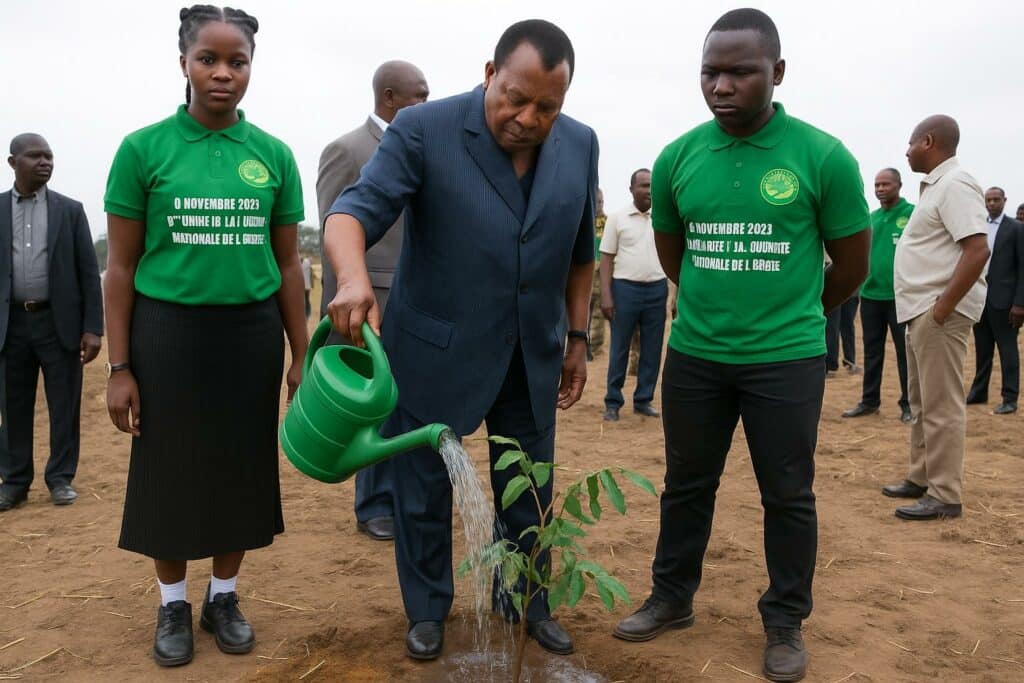Symbolic roots of National Tree Day
From the forested banks of the Alima River, President Denis Sassou Nguesso chose Oyo, his native town, to celebrate in advance the 39th National Tree Day on 2 November. Since a presidential decree of 1984 institutionalised the event for every 6 November, successive editions have sought to turn a ceremonial planting into a civic reflex. This year’s theme—“One tree, one forest, one plantation for a flourishing Congo”—invites each citizen to see personal action as part of a collective ecological tapestry. In the words of a senior forestry adviser present in Oyo, “the seed a schoolchild puts in the ground today underpins the sovereignty of the Congo Basin tomorrow.” Such rhetoric remains consistent with Brazzaville’s determination to couple environmental stewardship with national cohesion.
ProNAR’s pedagogic orchard in Oyo
The National Afforestation and Reforestation Programme (ProNAR) selected 2.5 hectares within the Lycée d’Excellence d’Oyo to host an experimental orchard and ornamental garden. Interim coordinator François Mankessi detailed the technical layout: 900 Terminalia mantaly saplings spaced five metres apart will form a green agora devoted to study and contemplation, while a quarter-hectare plot will accommodate roughly 100 grafted or marcotted fruit trees—mango, safou, orange, lemon and avocado varieties—with an expected first harvest within three years (Mankessi). For the pedagogical team, the site functions as an open-air laboratory where pupils can witness vegetative propagation techniques that gently reduce tree height and accelerate fruiting cycles.
Agroforestry and local livelihoods
The pits dug for the young trees—60 centimetres wide for fruit species, 30 centimetres for ornamentals—were enriched with an organic blend of Tithonia diversifolia and Echinochloa pyramidalis biomass. Between the rows, maize will be intercropped so that photosynthesis, soil cover and food security mutually reinforce one another. Such agroforestry design mirrors recommendations issued by the Central African Forests Commission, which regards diversified plots as buffers against both land degradation and rural poverty. Local smallholders invited to observe the ritual in Oyo expressed optimism that the model could be scaled up along secondary roads where arable land borders degraded gallery forest.
Diplomatic echoes and global commitments
France’s ambassador to Congo, Claire Bodonyi, paid tribute to what she described as “a foundational national act that unites communities around irreplaceable forest wealth” (Bodonyi). Her remarks resonate with the United Nations Decade on Ecosystem Restoration (2021-2030), under which Brazzaville has pledged to restore three million hectares. International partners often view Congo’s low deforestation rate—below 0.1 percent annually—as a comparative advantage in emerging carbon markets. By hosting a Blue Fund for the Congo Basin and presiding over climate summits in recent years, President Sassou Nguesso positions the republic as a convener able to translate symbolic spadework into geopolitical leverage.
At a glance: the stakes
Beyond ceremony, the 1,000 saplings put into the ground this week represent a carbon sink of roughly 250 tonnes over twenty years, assuming average growth rates for Terminalia and tropical fruit species. While modest beside Congo’s 22 million-hectare dense-forest massif, the gesture signals that urban and peri-urban landscapes must also absorb demographic pressure. Analysts at the Brazzaville-based Centre for Environmental Law note that decentralised plantings can cool microclimates, reduce dust loads and, crucially, foster a sense of place among young Congolese increasingly drawn to digital spaces.
Legal and economic outlook
Congo’s Forest Code of 2020 already obliges logging concessionaires to devote at least 75 percent of their surface to production forests managed under approved plans. The National Tree Day adds a bottom-up dimension by empowering individuals and schools. Economically, ProNAR hints at pairing its orchards with future value-chain initiatives—from fruit-processing micro-enterprises to eco-tourism circuits anchored in the school’s garden. According to a senior official at the Ministry of Forest Economy, feasibility studies are under way for results-based climate finance that would remunerate educational institutions for demonstrable biomass increase. Such instruments, if successfully piloted in Oyo, could unlock new revenue streams without compromising the president’s reiterated commitment to keep the Congo Basin “a solution forest” rather than a victim forest.

